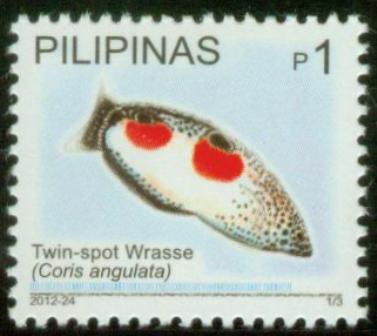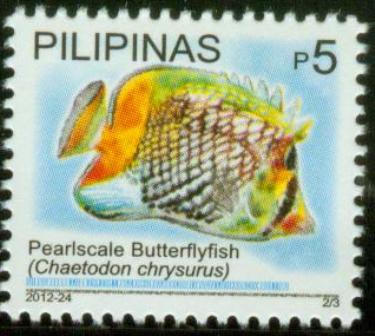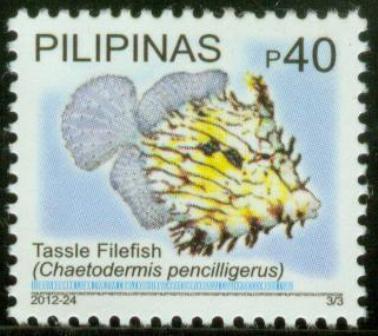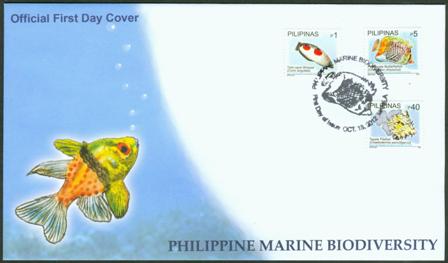2012, October 18. Philippine Marine Biodiversity - Definitives
Litho Offset. Amstar Company, Inc. Perf 13.5
Singles, Sheets of 100 (10 x 10)



1p Twin-Spot Wrasse - Singles (800,000)
5p Pearlscale Butterflyfish - Singles (750,000)
40p Tassle Filefish - Singles (750,000)
Layout Artist: Victorino Serevo
First Day Covers: Manila
PHILIPPINE FISHES
Twin-spot Wrasse
(Coris Angulata).
The Twin Spot Wrasse is also known as the Clown Wrasse. It is a very
large fish and is not recommended for aquarium life due to its size and
the difficulty in keeping it. It is an interesting fish for its color
patterns, which change markedly as it matures. The Twin Spot comes from
the Indo-Pacific region, including the Red Sea. Juveniles have a white
base with black spots on the front half and two large orange spots
against a white background on the upper back. There is black trim on the
fins. At about a foot in length, young adults change in color. Females
retain the small black spots and become dark green/grey on the back
half. Non breeding males are quite drab in appearance, while breeding
males turn a dark green with bands of light green and blue. The second
half of the body is marked by a distinct line where the color turns
darker and there may be white banding at this intersection. The scales
on the back half are more clearly defined. Breeding males will also have
secondary color patterns through their fins.
(http://saltwater.tropicalfishandaquariums.com/Wrasses/ClownWrasse.asp)
Pearlscale Butterflyfish (Chaetodon Chrysurus).
The Pearlscale Butterflyfish (Chaetodon xanthurus) is also known
as Yellow-tailed Butterflyfish or Philippines Chevron Butterflyfish.
It is found on or around the
reefs of the western Pacific Ocean from Indonesia and the Philippines
north to the Ryukyu Islands.
In the wild adults can grow to 15 cm with no discernible differences
between males and females. The body is pearly white and the scales have
black edges, giving the sides a more cross-hatched pattern.
Pearlscale butterflyfish are usually found at depths below 15 m
(49 ft). They are found in clear coastal to outer reef slopes and
drop-offs, often around staghorn corals. These fish have a peaceful
temperament and in the wild are found either alone, in pairs, or in
small groups, however they are territorial towards similar-looking
species and may harass them. Due to its attractive colors, the
Pearlscale Butterflyfish is a well-known aquarium fish.
In the wild they feed on algae, soft coral polyps and small
benthic invertebrates, so therefore along with other coral-eating
Chaetodon species they can wreak havoc on living corals in the aquarium.
They should be fed a variety of foods that can include mysid shrimp,
brine shrimp, krill, and foods containing algae.
(http://en.wikipedia.org/wiki/Pearlscale_butterflyfish).
Tassle Filefish (Chaetodermis pencilligerus).
The Tassle Filefish, also known as the Leafy Filefish or Prickly
Leatherjacket Filefish, is camouflaged by its light body with dark
horizontal stripes. They are
oddly-shaped fish often with dazzlingly cryptic patterns. Deeply keeled
bodies give a false impression of size. The
small terminal mouths of Tassle Filefish have specialized incisor teeth
on the upper jaw; four on the inner jaw and six on the outer jaw. The
snout is tapered and projecting; eyes are located high on the head.
Adult Tassle Filefish are generally shallow water fish,
inhabiting depths of no more than about 30 metres. They may be found in
lagoons or associated with seaward reefs and seagrass beds. The Tassle
Filefish are not terribly good swimmers,
their small fins confine the fish to a sluggish gait. The Tassle
Filefish are often observed drifting head downward amongst stands of
seaweed, presumably in an effort to fool both predator and prey alike.
When threatened, filefish may retreat to crevices in the reef. The
Tassle Filefish spawn at bottom sites prepared and guarded by the males,
both male and the female may guard the brood. The young filefish are
pelagic; that is, they frequent open water.
(http://www.freshmarine.com/tassle-filefish.html)
-
Fishes
-
Marine Life
